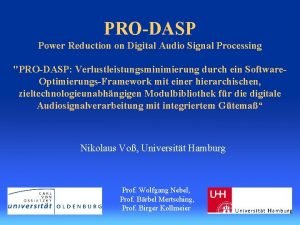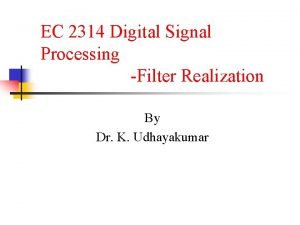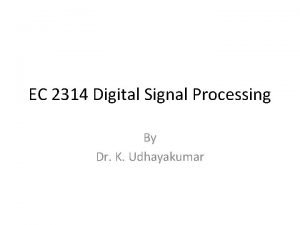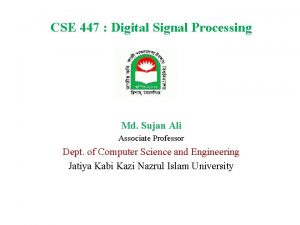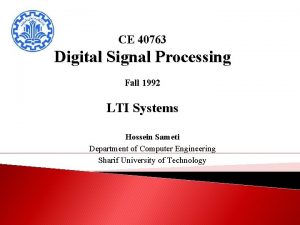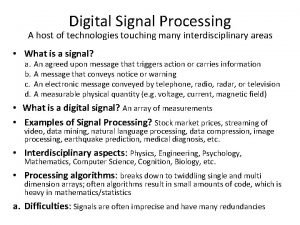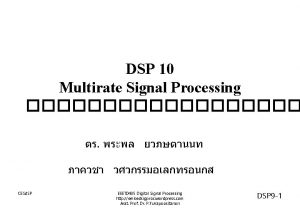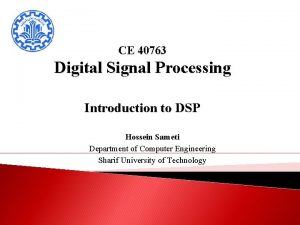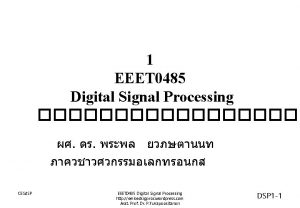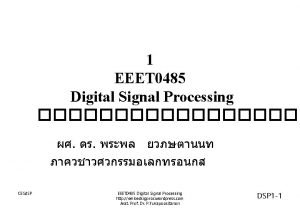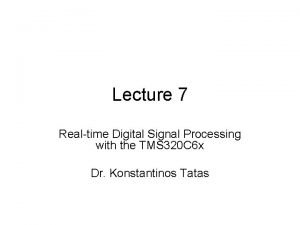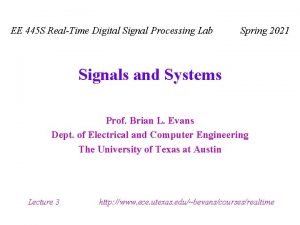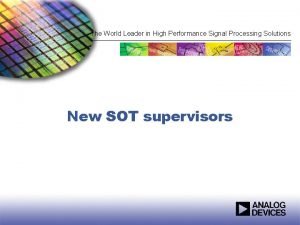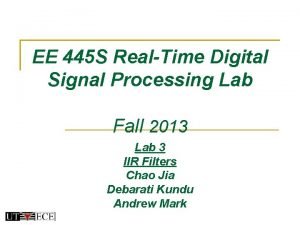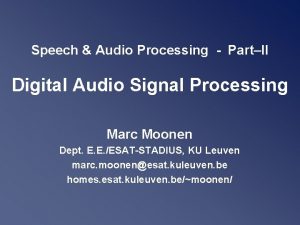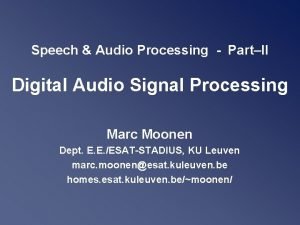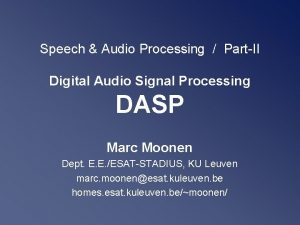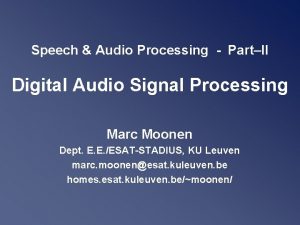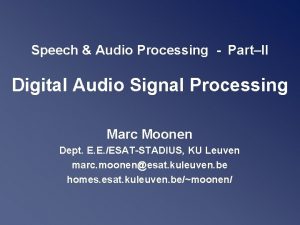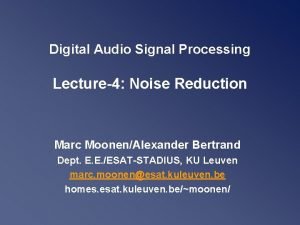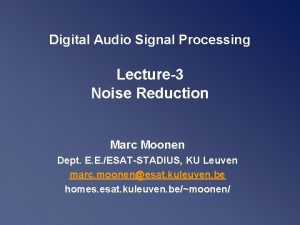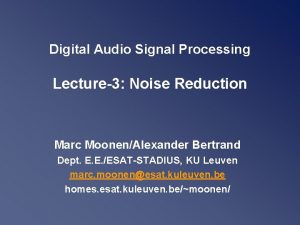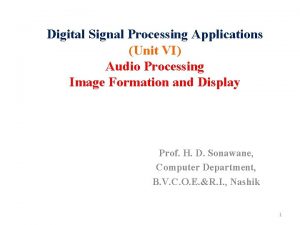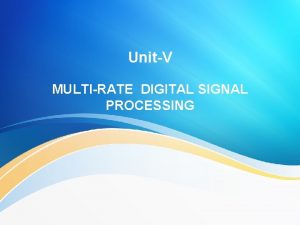PRODASP Power Reduction on Digital Audio Signal Processing

















- Slides: 17

PRO-DASP Power Reduction on Digital Audio Signal Processing "PRO-DASP: Verlustleistungsminimierung durch ein Software. Optimierungs-Framework mit einer hierarchischen, zieltechnologieunabhängigen Modulbibliothek für die digitale Audiosignalverarbeitung mit integriertem Gütemaß“ Nikolaus Voß, Universität Hamburg Prof. Wolfgang Nebel, Prof. Bärbel Mertsching, Prof. Birger Kollmeier

Structure • PRO-DASP cooperation • Motivation for our work • Design-Framework • Module structure and example with results • Conclusion Nebel, Mertsching, Kollmeier: PRO-DASP, DFG-Kolloquium 2003

Cooperation I • AG EHS Behavioral Power Analysis/Optimization • AG MEDI Audio-Algorithms and Quality Assessment • AG IMA Macro-Module Library and Design-Flow Verification Nebel, Mertsching, Kollmeier: PRO-DASP, DFG-Kolloquium 2003

Cooperation II ORINOCO® Qualityassessment MEDI Algorithmic Behavioral EIS Macro. Modules & Flow. Verification IMA funct. struct. RT Gate Netlist Layout Nebel, Mertsching, Kollmeier: PRO-DASP, DFG-Kolloquium 2003 Synthesis. Flow

Motivation • Existence of commerical power optimization for RTL and below • General behavioral estimation/optimization with ORINOCO • Specialized behavioral macros for low power audio signal processing Nebel, Mertsching, Kollmeier: PRO-DASP, DFG-Kolloquium 2003

Requirements 1. Multiple algorithmic module levels 2. Variety of transformations 3. Noise tolerance Þ Vast design space Þ Integration of macros into a designframework Nebel, Mertsching, Kollmeier: PRO-DASP, DFG-Kolloquium 2003

Design-Framework Features: 1. Power optimization on behavioral level 2. Generation of technology independend synthesis code 3. Allows (automatic) optimization on lower levels with other tools 4. Extensive applicability (hearing aids, mobile computing, …) 5. Easy to use Nebel, Mertsching, Kollmeier: PRO-DASP, DFG-Kolloquium 2003

Macro-Module Embedding • C++ prototype for simulation/quality assessment and parameter optimization • Generates specific (Behavioral-) VHDL implementation Audio-Data Audio-TB ORINOCO Module BC-VHDL Constraints Hardware Commercial Tools BC, DC, PC, SIM Nebel, Mertsching, Kollmeier: PRO-DASP, DFG-Kolloquium 2003

Arithmetic Modules • Low-Level modules Þ Can be combined with higher level modules • Multiple VHDL implementations possible: 1. Behavioral VHDL for constrained synthesis 2. RTL-VHDL with multiple architectures Nebel, Mertsching, Kollmeier: PRO-DASP, DFG-Kolloquium 2003

Arithmetic Module Hierarchy Arithmetic TL-Module Sign-Mag. 2 -compl. Float Logarith. RT-VHDL (1 stage) RT-VHDL (2 stage) Netlist B-VHDL Nebel, Mertsching, Kollmeier: PRO-DASP, DFG-Kolloquium 2003

Arithmetic Modules: Signal Stats I Nebel, Mertsching, Kollmeier: PRO-DASP, DFG-Kolloquium 2003

Float-Module: Quality • Example: FIR-Lowpass 44. 1 k. Hz, equiripple 10 -11 k. HZ, 112 Taps • Determine parameters for float-module via dynamic range evaluation and 3 -AFC Test (AG MEDI) Nebel, Mertsching, Kollmeier: PRO-DASP, DFG-Kolloquium 2003

Float Module: Power Target Tech. UMC 0, 18µm 1, 8 V 100 MHz Nebel, Mertsching, Kollmeier: PRO-DASP, DFG-Kolloquium 2003

HL-Transformationen I a) Direktform II b) Symmetr. Koeff. c) HODCMI 1) Hybrid optimal diff. Coeff. For multiplierless implem. (Muhammad & Roy (1997) Nebel, Mertsching, Kollmeier: PRO-DASP, DFG-Kolloquium 2003

HL-Transformationen II Nebel, Mertsching, Kollmeier: PRO-DASP, DFG-Kolloquium 2003

Conclusion • New approach in comparison to existing systems – Noise tolerance through integration of a valid audio quality measure – Multiple algorithmic module levels on the behavioral abstraction level – Optimizing modules embedded in a design-framework Nebel, Mertsching, Kollmeier: PRO-DASP, DFG-Kolloquium 2003

Outlook / Future Work • Integration of heuristic/probabilistic methods for module selection • Graphical user interface / integration into Matlab/Simulink • VLSI chip-design for example algorithm Nebel, Mertsching, Kollmeier: PRO-DASP, DFG-Kolloquium 2003
 Prodasp
Prodasp Digital signal as a composite analog signal
Digital signal as a composite analog signal Ec2314 digital signal processing
Ec2314 digital signal processing Types of signals
Types of signals Jatiya kabi kazi nazrul islam university logo
Jatiya kabi kazi nazrul islam university logo Digital signal processing
Digital signal processing Digital signal processing
Digital signal processing Digital signal processing
Digital signal processing Digital signal processing
Digital signal processing Digital signal processing
Digital signal processing Digital signal processing
Digital signal processing What is digital signal processing
What is digital signal processing Digital signal processing
Digital signal processing Time reversal property of z transform
Time reversal property of z transform High-performance digital signal processing
High-performance digital signal processing Digital signal processing
Digital signal processing Data encoding techniques in computer networks
Data encoding techniques in computer networks Histogram processing in digital image processing
Histogram processing in digital image processing
